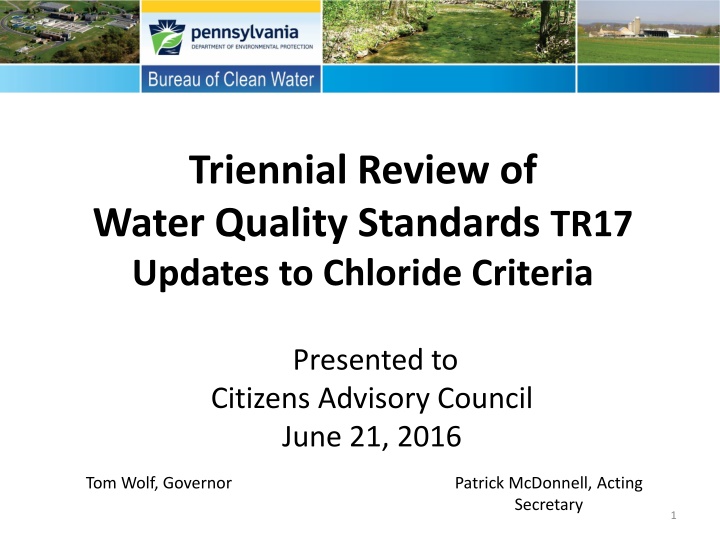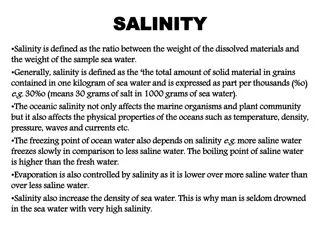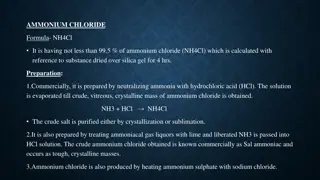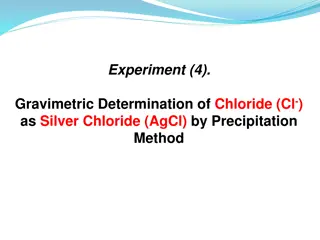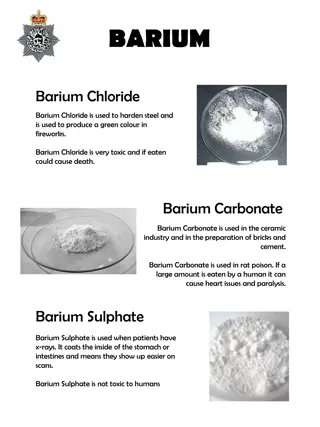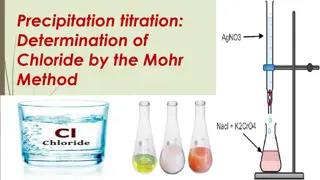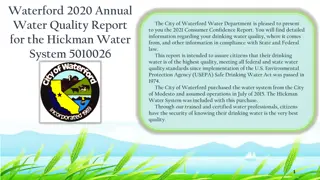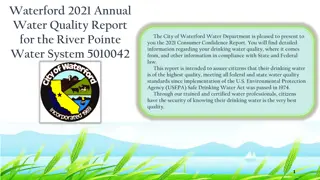Review of Water Quality Standards TR17 Updates & Chloride Criteria
Updates in the Triennial Review of Water Quality Standards TR17 regarding chloride criteria for water quality in Pennsylvania were presented to the Citizens Advisory Council. The need for protecting aquatic life statewide due to negative impacts from chloride concentrations, as well as insights on the ionic composition of freshwater sources, were discussed. Furthermore, an evaluation of chloride toxicity to freshwater organisms revealed NaCl as the least toxic compound.
Download Presentation

Please find below an Image/Link to download the presentation.
The content on the website is provided AS IS for your information and personal use only. It may not be sold, licensed, or shared on other websites without obtaining consent from the author.If you encounter any issues during the download, it is possible that the publisher has removed the file from their server.
You are allowed to download the files provided on this website for personal or commercial use, subject to the condition that they are used lawfully. All files are the property of their respective owners.
The content on the website is provided AS IS for your information and personal use only. It may not be sold, licensed, or shared on other websites without obtaining consent from the author.
E N D
Presentation Transcript
Triennial Review of Water Quality Standards TR17 Updates to Chloride Criteria Presented to Citizens Advisory Council June 21, 2016 Tom Wolf, Governor Patrick McDonnell, Acting Secretary 1
Current Chloride Criterion Pennsylvania s existing chloride criterion was developed primarily for the protection of potable water supplies (PWS use). The chloride criterion is not applied in all waters of this Commonwealth. It is applied only at the point of water supply intake. A maximum level of 250 milligrams of chloride per liter of water. 2
Need for Aquatic Life Use Protection Numerous toxicity tests show aquatic organisms found in Commonwealth waters are being negatively impacted by current chloride concentrations. Aquatic life protection must be applied statewide to all waters, in order to protect sensitive organisms. 3
Ionic Composition Freshwater sources are dominated by the cations Ca2+, Mg2+, K+ and Na+ and the anions HCO3- , SO42- and Cl-. (Wetzel, 1983) 4
Test Compound Determination Data obtained from stream surveys of Pennsylvania waters confirmed the ionic composition is: >40% HCO3-/ Ca2+, followed by SO42-, Mg2+, Na+, K+ and Cl-. Pennsylvania waters are calcium/bicarbonate dominant. 5
PA Water Ionic Composition Cedar Run Hardness = 212 UNT House Hardness = 94 MAGNESIUM 10% POTASSIUM 1% POTASSIUM 0% SODIUM 4% MAGNESIUM 19% SODIUM 3% SULFATE 8% BICARBONATE 41% BICARBONATE 41% SULFATE 4% CHLORIDE 1% CHLORIDE 4% CALCIUM 29% CALCIUM 35% Spruce Run Hardness = 6 White Clay Creek Hardness = 89 POTASSIUM 1% POTASSIUM 9% MAGNESIUM 17% BICARBONATE 24% BICARBONATE 31% MAGNESIUM 17% SODIUM 7% SODIUM 7% CALCIUM 18% SULFATE 9% SULFATE 21% CALCIUM 27% CHLORIDE 8% CHLORIDE 4% 6
Acceptable Test Product The order of chloride salt toxicity to freshwater organisms is KCl > MgCl2 > CaCl2 > NaCl. (Mount et al 1997) NaCl is the least toxic to aquatic organisms. Therefore, chloride toxicity to freshwater organisms was evaluated using NaCl as the test compound. Using NaCl ensures that the effect concentrations were derived from test where the effects are based on the chloride anion, not the associated cations. 7
Toxicological Study - Chloride EPA and Chapter 93 criteria development methodologies were used to derive acute and chronic chloride criteria. Data used was from: o approved U.S. EPA chloride toxicity dataset o results of the Stroud mayfly toxicity tests 8
Toxicological Study Acute Chloride Acute values were used from all acceptable data. This resulted in 219 acute toxicity results for aquatic species (51 genera). 9
Acute Chloride Data Set Genus Epioblasma Sphaerium Neocloeon Lampsilis Anafroptilum Ambystoma Ceriodaphnia Elliptio Procloeon Megalonaisas Lasmigona Margaritifera Brachionus Daphnia Isonychia Musculium Villosa Gyraulus Diaptomus Genus Physa Rana Pseudacris Lirceus Macaffertium Planorbella Ephemerella Limnodrilus Bufo Caecidotea Lumbriculus Nephelopsis Erpobdella Ameriurus Pimephales Tubifex Chironomus Leptophlebia Lithobates Genus Aciperser Cyprinella Lepidostoma Lepomis Carassius Gambusia Oncorhynchus Libellulidae Fundulus Gasterosteus Cambarus Anguilla Agria 10
Toxicological Study Acute Chloride Based on the lethal or effect concentrations (LC50 or EC50), the four genera most sensitive to acute testing were: GMAV mg/L Rank Genus/ Species Lampsilis (wavy-rayed lamp mussel) 4 991 3 Neocloeon (mayfly) 959 2 Sphaerium (fingernail clam) 785 1 Epioblasma (mussel) 698 11
Toxicological Study - Chloride The genus mean acute value (GMAV), 698 mg/L chloride includes the most sensitive organism (Northern Riffleshell). 12
Chronic Chloride Data Set The chronic toxicity data set included 10 aquatic species. Species Pimephales promelas (Fathead minnow) Oncorhynchus mykiss (Rainbow trout) Daphnia ambigua (water flea) Daphnia magna (water flea) Daphnia pulex (water flea) Ceriodaphnia dubia (water flea) Lumbriculus variegatus (worm) Neocloeon triangulifer (mayfly) Anafroptilum semirufum (mayfly) Procloeon fragile (mayfly) 13
Chronic Chloride Data Set The four species most sensitive to the chronic testing are: Rank Species SMCV mg/L Daphnia ambigua (water flea) 259 4 Procloeon fragile (mayfly) 239 3 Anafroptilum semirufum (mayfly) 160 2 Neocloeon triangulifer (mayfly) 153 1 14
Toxicological Study - Chronic Chloride The species mean chronic value (SMCV) for the most sensitive organism (Neocloeon triangulifer) is 153 mg/L chloride. 15
Calculation Definitions Genus Mean Acute Values (GMAV) is the geometric mean of the SMAV s. Final Acute Value (FAV) is calculated based on the GMAV s of the 4 organisms with a cumulative probability closest to 0.05. -If the FAV is calculated to be larger than the lowest GMAV, the lowest GMAV is used. Criteria Maximum Concentration (CMC) is equal to one half the FAV Acute/Chronic Ratio (ACR) - the calculated geometric mean of the available acute values for a species divided by the available chronic values The same dilution water must be used throughout the testing. Final Acute to Chronic Ratio (FACR) When sufficient chronic values are not available for species in eight families, an acute to chronic ratio is calculated. Criteria Continuous Concentration (CCC) is the CMC divided by the FACR 16
Chloride Criteria Calculated The final calculated acute/chronic ratio (FACR) from the acceptable data is 6.2. FAV (final acute value) FAV for lowest GMAV FACR = (geo mean of SMAV/SMCV) CMC = FAV for lowest GMAV/2 CCC = (FAV/FACR) 874.8 698 6.2 349 113 EPA has determined that the chloride toxicity is dependent on hardness and sulfate concentrations. As a result, the criteria will be equation based. 17
Recommended Aquatic Life Criteria The recommended, proposed chloride criteria will be calculated using the following equations*: Acute Chloride Criterion: CMC = 349 One hour average concentration should not exceed, more than once in three years Acute Criterion (mg/L) = CMC(Hardness)0.205797(Sulfate)-0.07452 Chronic Chloride Criterion: CCC = 113 4 day average concentration should not exceed, more than once in three years Chronic Criterion (mg/L) = CCC(Hardness)0.205797(Sulfate)-0.07452 *Hardness & sulfate exponents are based on studies done by the Great Lakes Environmental Center 18
The Department would like to thank you for helping us take this course in developing a PA specific criterion for chloride. Questions? Rodney Kime Bureau of Clean Water rkime@pa.gov (717) 787-9637 19
